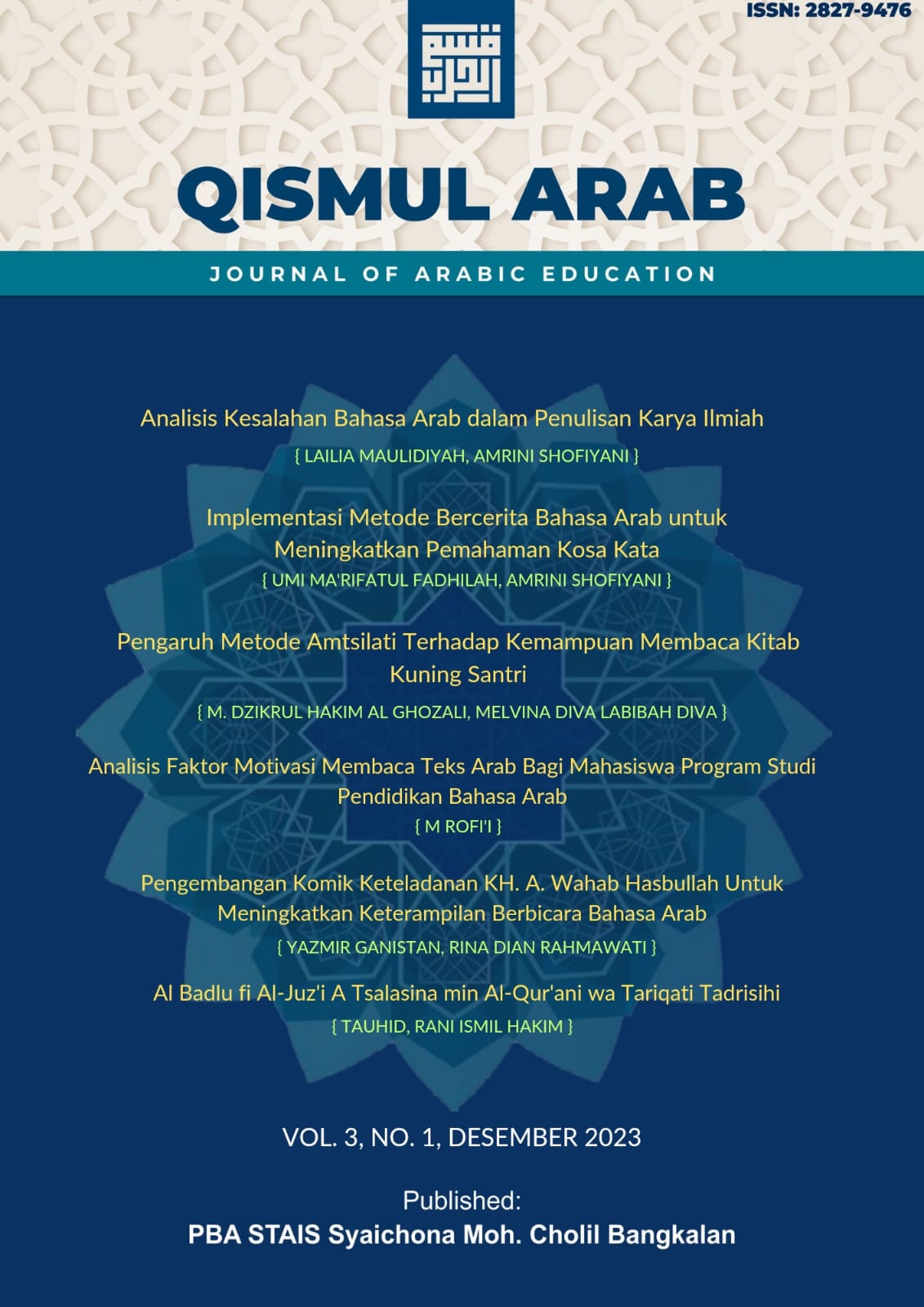Analisis Faktor Motivasi Membaca Teks Arab Bagi Mahasiswa Program Studi Pendidikan Bahasa Arab
DOI:
https://doi.org/10.62730/qismularab.v3i01.83Abstract
Motivation has a very strong influence on the cognitive and affective aspects of reading. Motivation affects a person's thinking style. When a person is interested in the text he reads, his understanding will increase more than when reading a text he is not interested in. This study describes the factors influencing the motivation for Arabic Language Education at STAI Syaichona Moh. Cholil Bangkalan will read Arabic texts in the Qira'ah lesson. Data collection techniques are carried out through interviews, observation, and documentation using descriptive qualitative methods. The collected data was analyzed and validated by the triangulation method. The results showed that six factors influence students' motivation to read Arabic text: (1) Reading ability. (2) Individual interest or desire. (3) Reading needs. (4) Social support. (5) Technology and learning resources. and (6) Supportive conditions and facilities.
References
Abdurrahman, M. (2012). Anak Berkesulitan Belajar: Teori, Diagnosis, dan Remidiasinya (Cet. 1). Rineka Cipta.
Bidari, R. A., Sa’diyah, R. R., Pambayun, S. P., & Wulandari, L. (2023). Analisis Penggunaan Teknologi Sebagai Sumber Belajar Berdasarkan Cone of Experience. Educate, 8(2), 148–156. https://doi.org/10.32832/educate.v8i02.9100
Cholid, C. (2022). Model NURS sebagai Alternatif Pembelajaran Keterampilan Membaca Bahasa Arab. Takuana: Jurnal Pendidikan, Sains, Dan Humaniora, 1(1), 26–39. https://doi.org/10.56113/takuana.v1i1.30
Di, P., & Alor, K. (2023). Jurnal Lazuardi - Volume 6 No.1 Maret 2023. 6(1), 36–52.
Fulmer, S. M., D’Mello, S. K., Strain, A., & Graesser, A. C. (2015). Interest-based text preference moderates the effect of text difficulty on engagement and learning. Contemporary Educational Psychology, 41, 98–110. https://doi.org/10.1016/j.cedpsych.2014.12.005
Hamm, J. M., Perry, R. P., Chipperfield, J. G., Hladkyj, S., Parker, P. C., & Weiner, B. (2020). Reframing Achievement Setbacks: A Motivation Intervention to Improve 8-Year Graduation Rates for Students in Science, Technology, Engineering, and Mathematics (STEM) Fields. Psychological Science, 31(6), 623–633. https://doi.org/10.1177/0956797620904451
Hermawan, D., & Nugroho, R. A. (2023). Tingkat Motivasi Pada Ekstrakurikuler Bolabasket Sman 1 Kedondong. Journal of Physical Education (JouPE), 4(1), 20–26.
Hidayah, N. L. (2020). Metode Pembelajaran Bahasa Arab Maharah Al-Qiro`Ah (Ketrampilan Membaca) Bahasa Arab Dengan Cara Membaca Di Depan Kelas Dan Ditirukan. Prosiding Konferensi Nasional Bahasa Arab VI, 246–253. http://prosiding.arab-um.com/index.php/konasbara/article/view/700
Hsb, F. F., Anwar, H., Is, F., Hadis, J. I., Estate, M., Percut, K., Tuan, S., & Deli, K. (2023). Argopuro: Jurnal Multidisiplin Ilmu Bahasa. 1(1).
Ilmiah, J., & Pendidikan, W. (2023). 5 12345. Jurnal Ilmiah Pendidikan, 9(3), 312–316.
Maziyah, L. (2018). Membaca Kritis Teks Arab Argumentasi: Teori dan Praktik. Konferensi Nasional Bahasa Arab, 4(2001), 73–81. http://prosiding.arab-um.com/index.php/konasbara/article/view/259
Mekarisce, A. A. (2020). Teknik Pemeriksaan Keabsahan Data pada Penelitian Kualitatif di Bidang Kesehatan Masyarakat. JURNAL ILMIAH KESEHATAN MASYARAKAT?: Media Komunikasi Komunitas Kesehatan Masyarakat, 12(3), 145–151. https://doi.org/10.52022/jikm.v12i3.102
Morris, L. S., Grehl, M. M., Rutter, S. B., Mehta, M., & Westwater, M. L. (2022). On what motivates us: A detailed review of intrinsic v. extrinsic motivation. Psychological Medicine, 52(10), 1801–1816. https://doi.org/10.1017/S0033291722001611
Normuliati, A. M. I. and S. (2022). Motivasi Membaca Kritis Teks Bahasa Arab (Analisis Faktor Motivasi Baca bagi mahasiswa Prodi PBA). Komposisi: Jurnal Pendidikan Bahasa, Sastra, Dan Seni, 23(2), 93. https://doi.org/https://doi.org/10.24036/komposisi.v23i2.112072
Orellana, P., Melo, C., Baldwin, P., De Julio, S., & Pezoa, J. (2020). The relationship between motivation to read and reading comprehension in chilean elementary students. Reading and Writing, 33(10), 2437–2458. https://doi.org/10.1007/s11145-020-10051-3
Palani, K. K. (2012). Promoting Reading habits and creating literate society. Journal of Arts,Science & Commerce, III(2), 90–94.
Putra, A. T., Herawati, J., & Kurniawan, I. S. (2022). Pengaruh Motivasi Intrinsik, Motivasi Ekstrinsik, Budaya Organisasi, dan Komitmen Organisasional Terhadap Kinerja Pegawai. Al-Kharaj?: Jurnal Ekonomi, Keuangan & Bisnis Syariah, 5(4), 1751–1765. https://doi.org/10.47467/alkharaj.v5i4.1974
Renninger, K. A., & Bachrach, J. E. (2015). Studying Triggers for Interest and Engagement Using Observational Methods. Educational Psychologist, 50(1), 58–69. https://doi.org/10.1080/00461520.2014.999920
Renninger, K. A., Ewen, L., & Lasher, A. K. (2002). Individual interest as context in expository text and mathematical word problems. Learning and Instruction, 12(4), 467–490. https://doi.org/10.1016/S0959-4752(01)00012-3
Sucipto, N., & Rauf, R. (2021). Pengaruh Disiplin Kerja sebagai Mediasi Hubungan Motivasi Intrinsik terhadap Kinerja Pegawai. YUME?: Journal of Management, 4(1), 6. https://doi.org/10.37531/yum.v11.76
Wahdah, Y. A. (2020). Faktor-Faktor Kesulitan Siswa Dalam Membaca Teks Bahasa Arab. Alsuniyat, 1(1), 30–46. https://doi.org/10.17509/alsuniyat.v1i1.24197
Downloads
Published
How to Cite
Issue
Section
License
Copyright (c) 2023 M Rofi'i

This work is licensed under a Creative Commons Attribution 4.0 International License.






